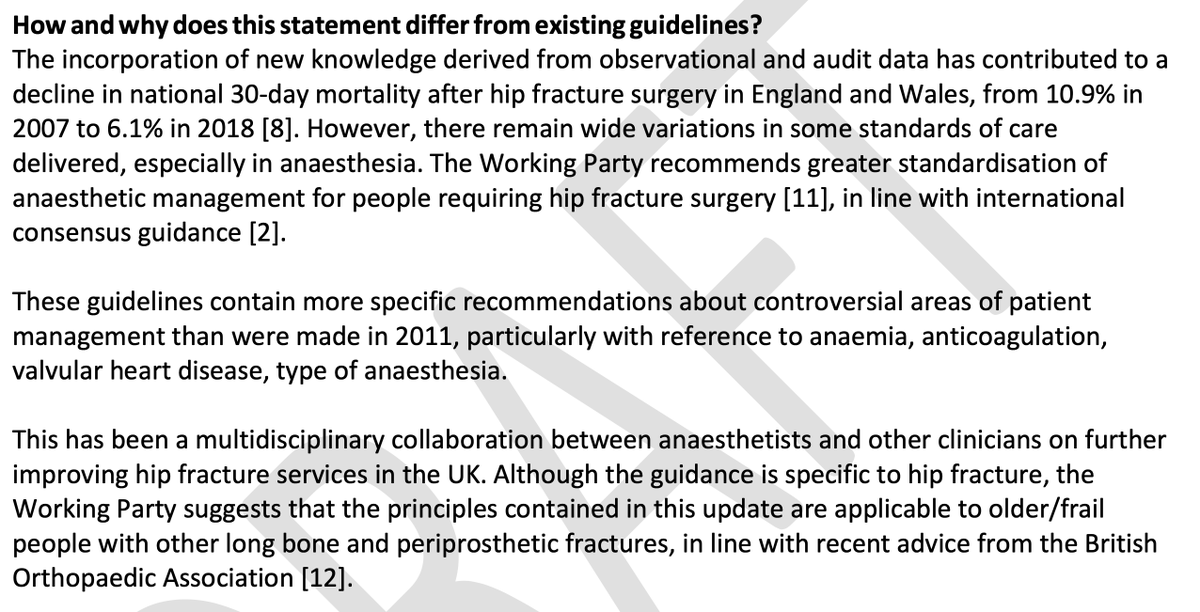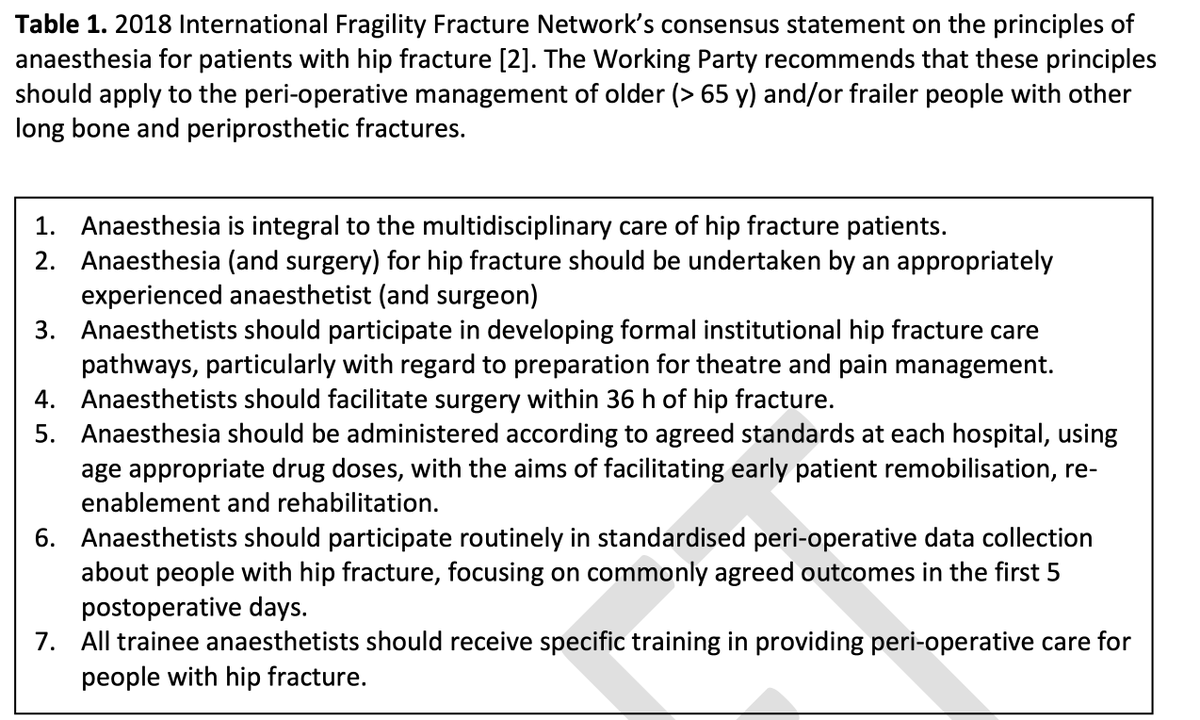
Congratulations to @neumanmd and the team for conception, completion and publication of the #REGAIN RCT of general (inhalational) vs spinal (with or without sedation) for people with #HipFracture. A huge achievement👏nejm.org/doi/full/10.10… Some thoughts... 1/ 🧵
...Anaesthetists seem to have been debating whether mode of anaesthesia for #HipFracture makes a difference for this group of often older, frailer people for decades now. Lots of strong opinions and a mixed bag of observational studies. So good grounds for the #REGAIN study 2/
...equally a lot of debate about whether one hour (or so) of anaesthesia will make a difference to a *patient-centred* outcome in the midst of a pathway involving ED, surgery, nursing, (ortho)geriatrics, pharmacy, physiotherapy, community care...3/
...so is #REGAIN the one trial to rule them all? Is #HipFracture anaesthesia settled once and for all now? 4/
...Some of my thoughts - using the PICO approach, with some side-tracks, digressions and random opinion thrown in. Population: Hat-tip to the #REGAIN team, they tried pretty hard to make the study population look like a 'normal' #HipFracture population 5/
...Notably, #REGAIN included people unable to consent for themselves who are often missed out. 👍 Main groups formally excluded were those with very poor mobility (ok) and a slightly odd (to my UK-eyes) exclusion around anticoagulation / anti-platelet agents 6/
...Of 22K patients screened in #REGAIN, 2.6K missed due to lack of staff, 3.5K declined, and 13K were excluded. Does that overall conversion rate of 7% raise concerns? 7/
...Around 1 in 4 of the exclusions in #REGAIN were for anticoagulant medication. Hard to translate that to other practices that may be more liberal with spinal anaesthesia and patients on anticoagulants / antiplatelets are by definition different to those who aren't...8/
...but personal view is that a) some people would insist on GA for #HipFracture plus blood thinners anyway (so not relevant) b) for those who would give spinals, hard to see how there would be a huge difference in effect compared to other trial participants 9/
...1328 potential participants had 'physician who declined partcipation' - there is a whole ethical debate around this, but relatively low numbers so doesn't make the study only of a niche 'not sure if it matters' group. Kudos to #REGAIN team for achieving that. 10/
...Intervention: #REGAIN was a pragmatic, real-world study. No doubt some people will say it doesn't reflect their practice. Inhalational only for the GA group. What about TIVA? Well, you'll have to wait for #VITAL I guess. pomctn.org.uk/VITAL 11/
...Intervention: No control over the spinal LA dose in #REGAIN. That's the real world. Higher doses are associated with more hypotension, but to my knowledge no-one has shown an association between spinal dose and patient outcomes after #HipFracture 12/
...Intervention: Sedation allowed in the spinal group. Has this inadvertently made the groups the 'same' - exposed to central-acting sedative agents? Possibly, but sedation was fairly light and again, real-world practice 13/
...Outcomes: There is legitimate debate about whether the #REGAIN outcome was the best one for people with #HipFracture, but it has several things going for it for me. 1) It was at a relevant time point - not too soon, not too late...13/
...Outcomes: 2) The #REGAIN outcome was relevant to people's life after #HipFracture - are they alive, and can they move around? Too many anaesthesia (and other studies) focussed on surrogates not important to patients and families 14/
...Outcomes: other outcomes such as Quality of Life metrics might have been chosen. Of course, I'm biased here, working with the WHITE team who use EQ-5D-5L 😉 online.boneandjoint.org.uk/doi/full/10.13… 15/
...Outcomes: delirium was assessed in #REGAIN using a validated tool.👍 If you want to be picky perhaps more frequent assessments could have been made, but not a major flaw for me 16/
... I'll let others delve into the statistical analysis of #REGAIN. As the authors state it turned out to be underpowered. Not their fault - power estimates are just that, estimates on the best data available. 17/
...The results! Not a jot of meaningful difference between mode of anaesthesia for #HipFracture . Primary outcome: 132/712 (18.5%) (spinal) vs 132/733 (18.0%) GA. Delirium, mortality, mobility, length of stay - all pretty much identical. 18/
...But of course [insert favourite subgroup here] definitely benefits from [insert favourite anaesthetic technique here] for #HipFracture. Not according to #REGAIN. Age, dodgy lungs, dodgy hearts - no difference (underpowered TBF). 19/
...but the patients were younger (plenty of older ones), length of stay was really short (that's US practice difference), too many exclusions (fair, but see tweets 6-10 - I think they did pretty well)...20/
... but #REGAIN doesn't reflect my practice! I know my patients do better with [insert favourite technique here]. Do you? What data do you have to show meaningful, patient-centred outcome differences in your individual practice? 21/
...so what should we do? Personal opinions 1) Make sure we can offer safe, effective and efficient spinal and general anaesthesia to people with #HipFracture 2) Don't tell patients that one technique is definitely better than another 22/
...we do know that #HipFracture outcomes are improved by orthogeriatric models of care with skilled, specialist teams. Supporting, promoting, integrating with them will benefit our patients. Mode of anaesthesia - probably not so much. 23/
I forgot to add some DOIs for transparency. I’m about 80% GA in my clinical #HipFracture practice; I’ve published observational studies on this topic (no differences); no involvement in #REGAIN; I was on TSC for #REGARD pilot RCT (delirium outcome)
• • •
Missing some Tweet in this thread? You can try to
force a refresh





